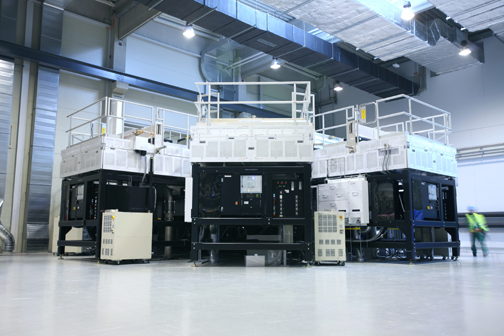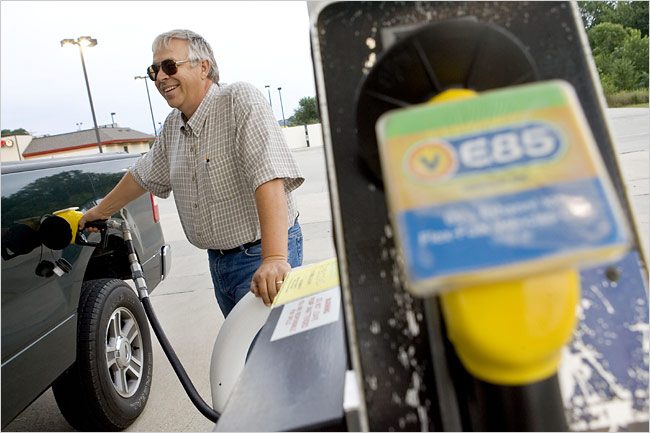 Applied SunFab Solar Module Production Line
Applied SunFab Solar Module Production Line
Well it certainly looks like the sun is paving the way for our new energy economy.
According to the Worldwatch Institute, an environmental research organization based in Washington, D.C., global solar photovoltaic (PV) power installations jumped from 9,000 megawatts in 2007 to nearly 15,000 MW in 2008, an increase of almost 66 percent. This is due primarily to government incentive programs in the world’s top PV markets, Spain and Germany.
Worldwatch provides a snapshot of solar power market trends globally:
- Global PV cell production nearly doubled in 2008, reaching 6,940 MW. The Chinese PV industry led silicon-based cell production, primarily to meet soaring demand in Spain and Germany.
- Europe remains the leading market for PVs, accounting for over 80 percent of world demand in 2008. Top markets Spain and Germany added 2,600 MW and 1,500 MW respectively. The United States came in a distant third, adding approximately 348 MW.
- Spain’s market growth increased a whopping 364 percent in 2008, causing it to overtake industry leader Germany as the number one solar PV market.
So what are Spain and Germany doing that the U.S. is not?
According to Dr. Charles Gay, the President of Applied Solar, a leading supplier of solar manufacturing equipment, Germany and Spain have set more immediate goals than the U.S. for increased use of renewable energy. They have also provided greater government investments to jumpstart the market.
Applied Solar also tells us that Americans are calling for more solar energy. The company has released a survey reflecting the general public’s understanding and opinions about solar energy.
According to the survey, Americans are calling for more solar energy thanks to its many advantages and faster integration of renewable power into the U.S. energy mix:
- Half of the people surveyed (50%) think the U.S. Government’s goal to have 25% of its power generated by renewable energy by 2025 is too slow.
- Four out of five (81%) agree that solar energy should play a greater role in meeting our nation’s energy needs in the next five years.
- More than two-thirds (68%) think utilities should include solar electricity as a part of their energy generation.
- Just over half (52%) would be willing to pay more per month if their utility company increased its use of renewable energy. But many consumers (41%) would not be willing to pay more, demonstrating the important role that government incentives, to bring down solar costs, will have on advancement of the technology.
Dispelling Myths and Providing Solar Solutions
Considerable progress has been made advancing solar technology during the past two decades, although many in the survey were not aware of this.
The survey also showed that Americans overestimate the amount of solar energy used in this country. One in five people stated that 20% or more of our energy comes from solar power. But solar energy accounts for less than 0.01% of U.S. energy generation, even though solar is already cost-competitive with fossil fuels for peak demand in such places as Hawaii, California, Arizona, and New York.
Another misconception held by over half of the persons surveyed is that solar panel installations on homes are the most efficient way to harness solar energy. In fact, “solar farms” represent an underutilized source for solar energy.
“Solar farms are generally large scale installations in the range of 10 to 100MW in scale,” says Dr. Gay. “By aggregating large numbers of large size panels and designing the system once, substantial cost savings can be achieved. The amount of energy lost in transmission is relatively small, generally less than 5%. Solar homes are typically up to 10kW in size and have a variety of one time design requirements for installation that do not share in the economies of scale possible with solar farms.“
The United States could supply its entire energy needs by covering just 1.6% of its land area with solar cells. In fact, putting solar cells on 1% of the area of global deserts would be sufficient to produce electricity for all the people in the world.
To review the full findings of this survey and learn more about Applied Materials’ solar photovoltaic business, visit http://www.appliedmaterials.com/summer.
Watch this video from Applied Solar to learn more about Applied Solar’s methods of harnessing the power of the sun.
More solar news:
- Advantages of Solar Energy
- Why Solar Energy?
- 7 Ways To Reduce Your Electricity Bill
- Price Of Solar Much Lower Than Solar Savings
- Which Solar Panels Are Most Efficient?
- What Is The Current Cost Of Solar Panels?
- Low Costs of Solar Power & Wind Power Crush Coal, Crush Nuclear, & Beat Natural Gas
- Dragon’s Guide To A 100% Renewable Home — Part 5 (Solar Panels)




I have a suspicion that in the oil depleted future, it will be those nations with the biggest renewable energy sectors that will come out on top. I think Spain and Germany have realised this and are planning for a future time when electrical power really is power, and that nations building their power base now will reap rewards later on.
Interestingly the USA and Australia, both of which are ideally situated to make use of solar energy, are not taking the issue seriously.
I have a suspicion that in the oil depleted future, it will be those nations with the biggest renewable energy sectors that will come out on top. I think Spain and Germany have realised this and are planning for a future time when electrical power really is power, and that nations building their power base now will reap rewards later on.
Interestingly the USA and Australia, both of which are ideally situated to make use of solar energy, are not taking the issue seriously.